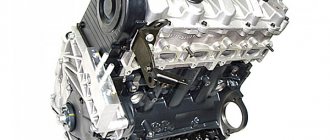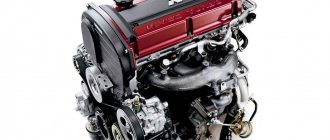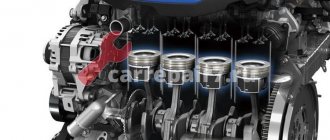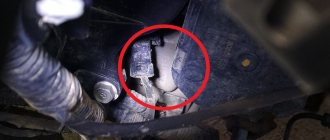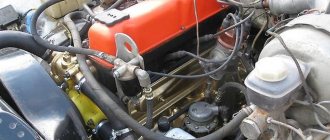Hyundai introduced the 1.6-liter in 2010 . This internal combustion engine replaced the G4FC engine, which was popular at that time . The new modification is equipped with Dual CVVT - a system of constant regulation of the gas distribution mechanism, which ensures more rational filling of the cylinders. The place of production of new engines is the Chinese city of Beijing , plans for setting up production in the Russian Federation have been announced.
G4FG Engine Characteristics
- marking – G4FG;
- Cylinder block – aluminum ;
- Power supply – injection ;
- ICE type – in-line ;
- Number of cylinders – 4;
- Valves per one - 4;
- Piston stroke – 85.4;
- ⌀ cylinder – 77;
- Compression Ratio – 10.5;
- V engine – 1591 cc. cm. ;
- Engine power – 121 – 132 hp. / 6200 - 6300 rpm per minute;
- Torque torque - 148 - 158 Nm / 4850 rpm. per minute;
- Fuel for G4FG – gasoline AI95 and higher;
- Environmental standard – Euro 4 and 5 ;
- Motor weight – approximately 100 kg;
- Oil consumption – up to 600 g. per 1000 km ;
- Engine oil – 5W-30 or -40 ;
- Engine oil volume – 3.3 l ;
- An oil change is required after 7.5 - 15 thousand km;
- The operating temperature of the internal combustion engine is 90 degrees Celsius;
- Timing drive – chain ;
Engine life is at least 300 thousand km.
Fuel consumption
Fuel consumption of G4FG engines for Kia Rio 4th generation (FB) with 6-speed manual transmission // 2nd generation Kia LED (JD) with 6-speed automatic transmission // 4th generation Kia Sportage QL with 6-speed manual transmission, l per 100 km:
- In the city - 8.9 // 9,5 // 8,6
- On the road - 5.3 // 5,4 // 5,6
- In a mixed cycle - 6,6 // 6,9 // 6,7
Engine characteristics
| Production | Beijing Hyundai Motor Co. |
| Engine make | G4FG |
| Years of manufacture | 2011-present |
| Cylinder block material | aluminum |
| Supply system | injector |
| Type | in-line |
| Number of cylinders | 4 |
| Valves per cylinder | 4 |
| Piston stroke, mm | 85.4 |
| Cylinder diameter, mm | 77 |
| Compression ratio | 10.5 |
| Engine capacity, cc | 1591 |
| Engine power, hp/rpm | 121/6200 123/6300 128/6300 130/6300 132/6300 |
| Torque, Nm/rpm | 148/4850 151/4850 155/4850 157/4850 158/4850 |
| Fuel | 95+ |
| Environmental standards | Euro 4 Euro 5 |
| Engine weight, kg | ~100 |
| Fuel consumption, l/100 km (for Kia Rio) - city - highway - mixed. | 8 4,8 6 |
| Oil consumption, g/1000 km | up to 600 |
| Engine oil | 0W-40 5W-30 5W-40 |
| How much oil is in the engine, l | 3.6 |
| Oil change carried out, km | 15000 (better 7500) |
| Engine operating temperature, degrees. | ~90 |
| Engine life, thousand km - according to the plant - in practice | — 300+ |
| Tuning, hp — potential — without loss of resource | 140 140 |
| The engine was installed | Hyundai Creta Hyundai Elantra Hyundai i30 Hyundai Solaris KIA Ceed KIA Cerato/Forte KIA Rio KIA Rio X-Line KIA Soul Hyundai Veloster Hyundai Venue |
Technical features of G4FG
Motor of the Gamma II series, labeled G4FG
The motor of the Gamma II series, labeled G4FG, was designed on the basis of the popular predecessor G4FC with the aim of replacing it. Let's list how the G4FG engine differs from its predecessor. The first thing changed was the pistons, although the crankshaft remained unchanged. The aluminum cylinder block is covered with a head with two phase shifters , i.e. system appeared on the cylinder head . The intake camshaft was made more aggressive.
A Dual-CVVT system appeared on the cylinder head
The VIS length change system on the intake manifold makes it possible to move normally at low speeds; the mechanism switches to 4200 rpm. in a minute .
The timing chain drive has a service life of more than 200,000 km.
There are no hydraulic compensators , so the valves need to be adjusted periodically . The Kia engine control unit has also been changed.
Kia/Hyundai G4FG 1.6 MPI engine: characteristics, features, reliability, breakdowns and service life
Good afternoon, today we will talk about how reliable, economical, maintainable and practical to maintain the Korean Kia gasoline engine
/
Hyundai 1
.
6 DOHC
MPI
fuel injection system
Gamma
/
Gamma
engine family
the G4FG
series .
In addition, the article will consider the issue regarding the maximum resource declared by the manufacturer for the motor and the most common breakdowns ( malfunctions
), factory problems, malfunctions (
problems
) identified by car owners during the operation of the
G4FG 1
.
6 Gamma
, which is equipped with such popular models of the
Kia
/
Hyundai
as
Hyundai Solaris
/
Creta
/
Elantra
, as well as
Kia Rio
/
Seltos
/
Sid
and many others.
A gasoline-type engine with a volume of 1.6 liters of
the G4FG
by
a Korean company from scratch, although, according to a certain proportion of experts, some internal combustion engine components were nevertheless borrowed from
Mitsubishi , but even if this was the case, the created power plant did not become worse.
The 1.6-liter power unit with the G4FG
belongs to the
Gamma
and, as we noted earlier, it is found under the hood of many medium-volume sedans, hatchbacks, station wagons and small crossovers from the
Kia
/
Hyundai
.
For the first time on the planet, the 16-valve engine in question is 1
.
6 G4FC
was presented in mid-
2010
at the international motor show in
Seoul
.
Gamma
motor fraternity includes
the following series of internal combustion engines
:
1
.
6 G4FD
,
1
.
4 G4FA
,
1
.
6 G4FC
and
1
.
6 G4FJ
.
{banner_adsensetext}The reviewed engine replaced its brother, the once insanely popular G4FC
.
G4FG
engine under consideration differs from
the G4FC
, primarily in the more advanced
Dual CVVT
.
Conveyor production of 1.6-liter power units of the G4FG
has been established near
Beijing
(
China
), where
from 2010
to the present (
for information: in the near future, the production of these internal combustion engines should also be launched near St. Petersburg, Russia
).
According to auto experts, the Gamma
, especially engine
1
.
6 G4FG
is rightfully considered one of the most popular versions of internal combustion engines, which are intended mainly for
budget
models of the Korean automaker, for example,
Kia Rio
and
Hyundai Solaris
.
How the G4FG 1 power unit works
.
6 DOHC MPI?
The design of the engine in question hardly stands out from competitors in the segment, with some special uniqueness.
G4FG
engine has distributed fuel injection -
MPI
.
The head and cylinder block are made of high-melting aluminum, and the plastic intake manifold has a variable length. The power plant is equipped with a DOHC
/
DOHS
with two camshafts with 16 valves.
The gas distribution system is composed of a single-layer timing chain
with a hydraulic tensioner, and phase regulators are located on both shafts, operating as
Dual CVVT
. As for hydraulic compensators, they are not installed in this internal combustion engine.
{banner_reczagyand}
Distinctive features and technical characteristics of the Kia
/
Hyundai G4FG engine 1
.
6MPI _
How economical is the power 1
.
6-liter unit of the G4FG series from the Gamma line?
Which generations of
Kia/Hyundai
by year of manufacture . 6 G4FG DOHC MPI ?
What are the pros and cons of the power unit 1
.
6 G4FG DOHC MPI ?
What common breakdowns, problems and sores are the motor 1 famous for
?
6 G4FG DOHC MPI ?
As a basis for compiling a list of the most common problems and factory defects that are typical for an atmospheric power plant
1
.
6 G4FG
in operation, we took real
reviews
from owners and
opinions
of experts from the sites Drive2.ru and Drom.ru, well-known among car enthusiasts.
1
.
Many car owners often complain about floating engine speeds. Typically, the problem occurs due to excessive contamination of the intake system. This problem can be easily resolved by cleaning the manifold and throttle valve ( step-by-step instructions for resolving the problem are described in detail on specialized websites
).
2
.
After 90-100 thousand
kilometers, a fairly large proportion of car owners often experience oil fogging in the valve cover area.
The problem, as a rule, is solved by replacing the factory gasket with a third-party one, but the problem is resolved only for a while. 3
.
After 50-60 thousand
kilometers, an ear-piercing whistle may appear from under the hood, from an idling engine.
A similar sound comes from the accessory belt. The problem can be solved by tightening the belt drive, but sometimes you have to change the belt tensioner itself. 4
.
scuffing
is not uncommon .
According to auto experts, scuffing on this engine appears due to the ceramic core of the catalyst
, which quickly crumbles and is drawn back into the internal combustion engine system (
the working area of the cylinders, causing mechanical damage to the surface layer of the walls
). The problem is solved by removing the catalyst and reflashing the power unit, and the sooner this is done, the better it will be for the engine, since scuffing inevitably leads to capital damage.
Routine maintenance of naturally aspirated Kia/Hyundai engine 1
.
6 G4FG DOHC MPI
How much does a new and contract Kia/Hyundai G4FG 1 power unit cost on the market
?
6 DOHC MPI Gamma?
What similar petrol versions of engines from other manufacturers exist?
To the same type of power units, mirror-like
G4FG 1
.
6 DOHC MPI
from Kia/Hyundai
can be attributed
: Toyota 1ZR‑FAE, VAZ 21129, BMW N13, Chevrolet F16D4, Opel Z16XEP, Ford L1N, Peugeot EC5 and Nissan QG16DE.
Video: “DOHC system engines: features, principles of operation, advantages and disadvantages”
In conclusion, we note that the Korean 1.6-liter G4FG series atmospheric power unit with the DOHC system from Kia/Hyundai can safely be called quite reliable, moderately economical in relation to the output power and practical in repair/maintenance compared to its counterparts in the Gamma motor line.
The minimum service life declared by the manufacturer for the engine is 180-200 thousand
kilometers.
As a rule, the actual resource of the internal combustion engine in question often reaches 250-300 thousand
kilometers before a serious malfunction or major repair.
Thus, the durability of almost any modern engine, be it gasoline or diesel, turbocharged or naturally aspirated, directly depends on the rules of operation of the car by the car owner and the frequency of replacing consumables with technical fluids. THANK YOU FOR YOUR ATTENTION
.
SUBSCRIBE TO OUR NEWS
.
SHARE WITH YOUR FRIENDS
.
G4FG service
Hyundai/Kia G4FG engine
Oil requires regular replacement every 15,000 km . At the same time, the G4FG engine contains 3.3 liters of lubricant , i.e. when replacing, you will need 3 liters 5W oil with a viscosity of 30 or 40 .
Hyundai/Kia oil with viscosity 5W30
It is better to change a single-chain timing drive every 150,000 km.
Every 100,000 km, the G4FG valves need to be adjusted to set normal thermal clearances. At the inlet they should be 0.20 , at the outlet - 0.25 millimeters
. Adjustment - selection of pushers.
Air filter for G4FG engine
The air filter is changed every 15,000 km . After 30,000 km, you need to change the ignition elements - spark plugs. Poly V-belt , fuel filter is the one in the tank - after 60,000 km . Every 120,000 , that is, approximately once every 8 years , the antifreeze must be completely replaced.
Hyundai long life coolant (green) with article number 07100-00400 - four-liter canister, 07100-00200 - two-liter canister.
Advantages and disadvantages, weaknesses of G4FG
The advantages of the G4FG engine include the fact that it rarely breaks down , maintenance is extremely simple, inexpensive spare parts the power is also impressive with low fuel consumption.
However, the G4FG engine also has some disadvantages: it is noisy during operation, requires valve adjustment vibrates noticeably at medium speeds , and the cylinders are prone to scuffing .
Let's list the main problems of the Korean engine for Kia Rio or Hunday Solaris.
- The engine knocks , but if after warming up the Kia Rio engine the knock disappears, then 90% of the time the reason is not in the internal combustion engine , but in the G4FG timing chain. If the knocking noise persists after warming up, it is most likely coming from unset valves .
- Noises reminiscent chirping, clicks, clatter, always accompany normal injector operation, so you shouldn’t pay attention to such sounds.
G4FG injectors - The valve covers have a gasket that sometimes leaks oil. If you don't like oil leaks, replace this gasket and the problem will go away.
- The Kia Rio engine operates unevenly, with floating speed . In this case, the throttle body may need to be cleaned. If this does not have an effect, you will need to reflash the G4FG internal combustion engine.
- Idle speed is accompanied by vibration . The spark plugs or a dirty throttle valve may be to blame. Faulty engine mounts can transmit severe vibration.
- Vibration at medium speeds . The G4FG has such an inexplicable feature - at 3000 rpm a strong vibration occurs. Car experts say that the design of the engine mount is to blame for this, due to which it begins to resonate at such speeds. Therefore, vibration is felt everywhere, incl. on the steering wheel. To get rid of the unpleasant phenomenon, you need to either release the gas or add it.
- A loose belt may whistle . To get rid of this sound, you need to change the tensioner pulley.
- Since 2011, G4FG engines are distinguished by weak (for Russian fuel) catalysts , which fail after 50,000 km . The greatest danger of this phenomenon is that sand from the destroyed catalyst scratches the cylinders, which causes excessive oil consumption and may require engine overhaul. A similar problem is not typical for Kia Rios until 2011, which were equipped with “ram’s horn” type exhaust manifolds.
Tuning
To tune the G4FG engine, factory spare parts for the Kia Rio are not provided . Using ready-made solutions, you can only remove the standard exhaust , make a cold intake , make a direct 4-2-1 manifold with a diameter of 51 mm .
By reflashing the control unit and removing the catalyst, you can then increase the engine power to 140 hp. and higher.
“Do-it-yourselfers” can install camshafts with plates, a new 4-1 manifold and exhaust pipe ⌀ 63 mm . By replacing the standard control unit , you can spin the engine up to 8000 rpm and get a significant increase in power.
Hyundai-Kia G4FG engine tuning
Chip tuning
This is the worst engine in terms of hardware in the entire Gamma line, so using factory spare parts for tuning will not work. You can only organize a cold intake, remove the standard exhaust and weld a normal one in the form of a 4-2-1 manifold and a straight line with a diameter of 51 mm. For this, as well as for operation without a catalyst, you need to flash the control unit and in the end you will get 140 hp. You can go further and put Nuzhdin camshafts with plates, a 63 mm exhaust with a 4-1 manifold, set it all up on a third-party ECU and spin it at 8000 rpm, then the power will increase significantly.
240
What cars was G4FG installed on?
KIA:
- Rio 4 from 2021,
- Soul 2 from 2014,
- Seed 2 2012-2018,
- Cerato 2 2012-2018.
Let's list which Hyundai cars the G4FG was installed on.
- From 2010 to 2015 – on Elantra 5 ,
- From 2012 to 2021 – on i30 2 ,
- From 2012 to 2021 – on Ceed 2 and Cerato 2 ,
- Since 2014 – on Soul 2 ,
- From 2015 – on Elantra 6 ,
- From 2021 – on Hyundai Accent HC and Creta 1 ,
- From 2021 – on i30 3 , Solaris HC , Kia Rio 4 .




